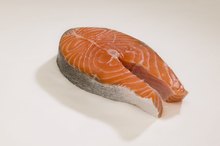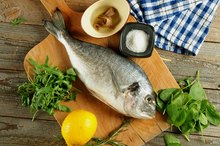What does fact checked mean?
At Healthfully, we strive to deliver objective content that is accurate and up-to-date. Our team periodically reviews articles in order to ensure content quality. The sources cited below consist of evidence from peer-reviewed journals, prominent medical organizations, academic associations, and government data.
- Office of Dietary Supplements: Selenium
- Linus Pauling Institute: Vitamin D
- Harvard School of Public Health: Vitamin D and Health
The information contained on this site is for informational purposes only, and should not be used as a substitute for the advice of a professional health care provider. Please check with the appropriate physician regarding health questions and concerns. Although we strive to deliver accurate and up-to-date information, no guarantee to that effect is made.
Rockfish Nutrition Facts
Pacific red snapper, black bass, rock cod and ocean perch don’t sound like they’re related, yet they’re all different types of rockfish. Most rockfish come primarily from the Pacific Ocean, where they thrive at such a deep depth that they can be damaged if they're pulled to the surface too quickly. All types of rockfish provide low-calorie protein, and they're good sources of selenium and vitamin D.
Tips
Rockfish has 109 Calories and 22.23 g of Protein per 100 gram serving according to the nutrition facts provided by the USDA Food Composition Database.
Identifying and Cooking Rockfish
The generic name "rockfish" refers to more than 70 species of fish that all belong to the Sebastes genus. Fish from this group often carry names reflecting their diverse colors, which range from green, blue and red to brown, copper and black. Others are known by their physical characteristics, such as pygmy, yelloweye, thornyhead and chilipepper. Rockfish fillets have a firm texture that holds up in soups and stews. They work well baked, steamed, fried and sauteed, but they’re not sturdy enough to grill, according to SeafoodSource.com.
- The generic name "rockfish" refers to more than 70 species of fish that all belong to the Sebastes genus.
- Fish from this group often carry names reflecting their diverse colors, which range from green, blue and red to brown, copper and black.
Rich Source of Lean Protein
Vitamins in Shrimp
Learn More
When you’re looking for an excellent source of lean protein, rockfish makes a good choice. A 3-ounce serving supplies 19 grams of quality protein, which is 41 percent of women’s and 33 percent of men’s recommended daily intake for protein. The same portion contains 1.4 grams of total fat. Based on a 2,000-calorie-a-day diet, the fat in one serving of rockfish is barely 1 percent of total daily calories. This easily fits with Institute of Medicine recommendations to consume 20 to 35 percent of your daily calories from fats. The total fat in rockfish includes less than 1 gram of saturated fat and 52 milligrams of cholesterol.
- When you’re looking for an excellent source of lean protein, rockfish makes a good choice.
- A 3-ounce serving supplies 19 grams of quality protein, which is 41 percent of women’s and 33 percent of men’s recommended daily intake for protein.
Daily Supply of Selenium
You don’t need to consume a lot of selenium -- just 55 micrograms daily -- but it’s a vital nutrient. Selenium is a major component of selenoproteins, which regulate thyroid hormones and produce antioxidants. A 3-ounce serving of rockfish contains 65 micrograms of selenium. Since too much selenium becomes toxic, the Food and Nutrition Board of the Institute of Medicine established a maximum upper intake of 400 micrograms daily. Beware of combining several sources of high-selenium foods in one day. For example, Brazil nuts have 544 micrograms in a 1-ounce serving, while a serving of tuna, halibut, ham, poultry or beef steak supply half of the recommended daily allowance.
- You don’t need to consume a lot of selenium -- just 55 micrograms daily -- but it’s a vital nutrient.
- For example, Brazil nuts have 544 micrograms in a 1-ounce serving, while a serving of tuna, halibut, ham, poultry or beef steak supply half of the recommended daily allowance.
Natural Source of Vitamin D
Nutrition of Salmon Burgers
Learn More
As a group, fish are one of the few natural sources of vitamin D. Finding foods that supply vitamin D is important. Even though it's produced in your skin from ultraviolet light, you may not get enough exposure to the sun to make a sufficient amount, according to the Harvard School of Public Health 5. Lack of vitamin D leads to weak bones and osteoporosis because your body can’t absorb and use calcium without it. You also need vitamin D to keep your immune system strong. You'll get 156 IU of vitamin D from a 3-ounce serving of rockfish. The recommended dietary allowance established by the Institute of Medicine is 600 IU 2.
Related Articles
References
- NutritionValue.org: Fish, Dry Heat, Cooked, Mixed Species, Pacific, Rockfish
- Office of Dietary Supplements: Selenium
- Linus Pauling Institute: Vitamin D
- Harvard School of Public Health: Vitamin D and Health
- SeafoodSource.com: Seafood Handbook -- Rockfish
- Marine Science Institute: Rockin’ the Rockfish
Writer Bio
Sandi Busch received a Bachelor of Arts in psychology, then pursued training in nursing and nutrition. She taught families to plan and prepare special diets, worked as a therapeutic support specialist, and now writes about her favorite topics – nutrition, food, families and parenting – for hospitals and trade magazines.









